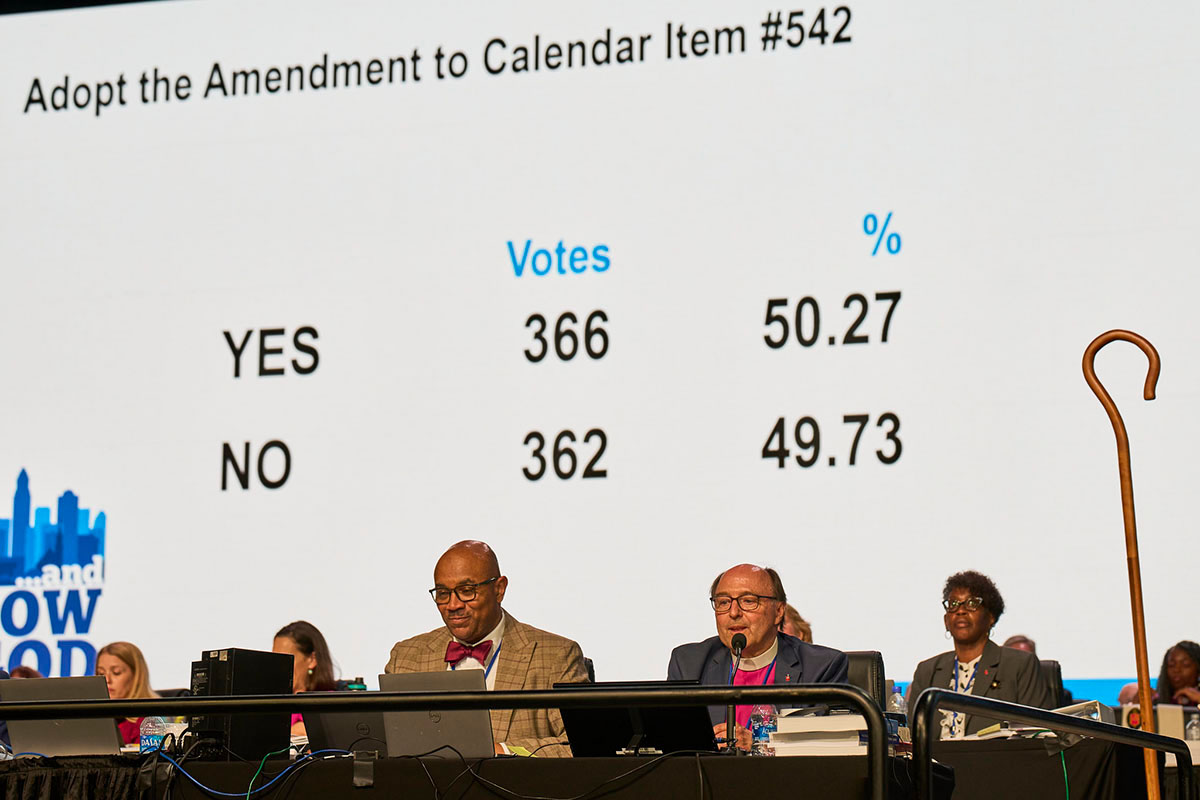Key Points:
- After vigorous debate, delegates voted to reduce the base rate — a key component used in calculating requested annual conference apportionments.
- Ultimately, delegates voted to reduce the base to 2.6% for 2025 and 2026.
- If apportionment collection rates are 90% or higher, the base rate will increase to 2.9% in 2027 and 2028.
Delegates voted to reduce a key component of calculating apportionments — the portion of church giving requested to fund the general-church budget.
During an afternoon session on April 30, delegates passed the new base rate for The United Methodist Church’s apportionment formula in the most contested plenary vote so far at this year’s General Conference.
As a result, conferences will shift from their current base rate of 3.29% to a base rate of 2.6% for 2025 and 2026. Then, if the apportionment collection rate is 90% or higher in those years, the base rate will jump to 2.9% for 2027 and 2028.
Bottom line: U.S. annual conferences will be asked to pay lower apportionments compared to what delegates passed at the 2016 General Conference. Also, denomination-wide ministries that rely on those apportionments — including general agencies and episcopal leadership — will need to be budgeted with those cuts in mind.
General Conference will vote on the full denomination-wide budget on its final day, May 3.
The vigorously debated action took more than an hour and a half to complete, with a call for centering prayer in the midst. But by the time the final vote was cast, many were calling the work a strong example of holy conferencing.
Subscribe to our
e-newsletter
Delegates were voting on Petition 21124, which was a revision to the General Council on Finance and Administration’s proposed based percentage of 2.5954212777 in GCFA’s Report No. 8, Apportionment Formulas.
The Financial Administration legislative committee had recommended increasing that base rate to 2.9% in the petition that went before the body.
On behalf of the committee, the Rev. Drew Dyson said the 2.9% rate strikes a balance between support for local ministry and a commitment to God’s church.
“It reflects our values and commitments as a church,” Dyson said.
However, Don House, speaking on behalf of the committee’s minority report, said he and others on the committee recommended 2.6% instead, citing a need to be mindful of church health. House said The United Methodist Church has gone from a 91.8% collection rate in 2016 to 73.7% in 2022 and to a projected 68.5% in 2024. He noted the 2.6% rate, while rounded up from the GCFA’s proposed 2.5954212777, was what GCFA had spent “countless hours” researching and ultimately recommending.
“Our overall goal is to have sufficient health among churches to provide adequate funding for the agencies,” House said.
Delegates debated both the committee report and the minority report, ultimately voting 455-266 to substitute the minority report.
As Amy King, delegate from the North Georgia Conference, noted about her local church, “Every Sunday it’s a guess if we will have a working HVAC system, yet since 2016, general-church assets have increased from $136 million to $509 million, and that’s unrestricted net assets. Increasing the base rate will increase the cost for local church.”
Committee Chair Scott Brewer moved the body refer the petition back to GCFA for further review, but delegates hotly debated this, too, voting down by a slender margin (372-342) the motion to refer.
Minnesota delegate Dave Nuckols stood to propose an amendment to the minority report, which would start with a base rate of 2.6% for 2025 and 2026 but shift to 2.9% for 2027 and 2028. As Nuckols explained, many in the United States are facing significant financial pressure following disaffiliation and feel a significant relief from apportionments is appropriate, yet they simultaneously place great value on connectionalism and funds such as The Black College Fund and Africa University, both of which the base rate supports.
“Two years (at 2.6%) will give some relief … and then 2.9% in the last two years will bring us closer to where we have traditionally been,” Nuckols said.
After strong debate for and against, the body voted to amend the motion by 366-362, a 50.27% majority.
Delegate the Rev. Jay Williams of the New England Conference called Nuckols’ amendment a “fair and balanced approach to our present realities.”
An amendment from Florida Conference delegate the Rev. Cynthia Weems proposed raising the base percentage from 2.6% to 2.9% only if the apportionment collection rate is 90% or higher in 2025 and 2026.
Upon request, GCFA top executive Moses Kumar said 2018 was the last time The United Methodist Church had achieved more than 90%.
Amid the debate, the Rev. Beverly Wilkes-Null called for a moment of prayer.
After this, the amended-amended motion passed 461-272.
The final vote on the full petition as amended passed 640-94.
After the vote, presiding Bishop David Alan Bard, Michigan Conference, praised the body for their lengthy but important work for the church.
“Friends, we did some heavy lifting — a minority report, multiple amendments — so thank you for your good work.”
Jessica Brodie is editor of the South Carolina United Methodist Advocate.
News media contact: Julie Dwyer at (615) 742-5470 or newsdesk@umnews.org. To read more United Methodist news, subscribe to the free daily or weekly Digests.




